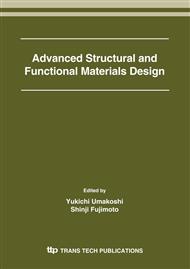[1]
G. Dougherty: Med. Eng. Phys. Vol. 18 (1996), p.557.
Google Scholar
[2]
B. D. Synder, S. Piazza, W. T. Edwards and W. C. Hayes: Calcif. Tissue Int. Vol. 53 (1993), p. S14.
Google Scholar
[3]
J. C. Elliot: Structure and chemistry of the apatites and other calcium phosphates (Elsevier, Amsterdam 1994).
Google Scholar
[4]
W. J. Landis: Bone Vol. 16 (1995), p.533.
Google Scholar
[5]
T. Nakano, Y. Tabata and Y. Umakoshi: Texture and Bone reinforcement, Encyclopedia of Materials: Science and Technology -Updates, Edited by K. H. J. Buschow, R. W. Cahn, M. C. Flemings, E. J. Kramer, P. Veyssiere et al. (2005), in press.
DOI: 10.1016/b0-08-043152-6/02061-1
Google Scholar
[6]
T. Nakano, K. Kaibara, Y. Tabata, N. Nagata, S. Enomoto, E. Marukawa, Y. Umakoshi: Bone Vol. 31 (2002), p.479.
DOI: 10.1016/s8756-3282(02)00850-5
Google Scholar
[7]
S. M. Clark, J. Iball: Progress in Biophysics Vol. 7, Chapter 5 (Pergamon Press, London 1957), p.226.
Google Scholar
[8]
N. Sasaki, N. Matsushima, T. Ikawa, H. Yamaura and A. Fukuda: J. Biomech. Vol. 22 (1989), p.157.
Google Scholar
[9]
P. Roschger, B. M. Grabner, S. Rinnerthaler, W. Tesch, M. Kneissel, A. Berzlanovich, K. Klaushofer and P. Fratzl: J. Struct. Biol. Vol. 136 (2001), p.126.
DOI: 10.1006/jsbi.2001.4427
Google Scholar
[10]
T. Yamamoto, H. Nakamura, T. Tsuji and A. Hirata: Anat. Rec. Vol. 264 (2001), p.25.
Google Scholar
[11]
T. Nakano, K. Kaibara, Y. Tabata, N. Nagata, S. Enomoto, E. Marukawa, Y. Umakoshi: Tissue Engineering for Therapeutic Use 6, Edited by Y. Ikada, Y. Umakoshi and T. Hotta (Elsevier Science, Amsterdam 2002), p.95.
Google Scholar
[12]
T. Ishimoto, T. Nakano, Y. Umakoshi, M. Yamamoto and Y. Tabata: Mater. Sci. Forum (2005), in press.
Google Scholar
[13]
C. T Lindsey, A. Narasimhan, J. M. Adolfo, Hua Jin, L. S. Steinbach, T. Link, M. Ries and S. Majumadar: OsteoArthritis and Cartilage Vol. 12 (2004), p.86.
DOI: 10.1016/j.joca.2003.10.009
Google Scholar
[14]
J. -W. Lee, T. Nakano, A. Kobayashi, K. Takaoka, Y. Tabata and Y. Umakoshi: Phosph. Res. Bull. Vol. 17 (2004), p.83.
Google Scholar
[15]
S.L. Abboud, K. Woodruff, C. Liu, V. Shen, and N. Ghosh-Choudhury: Endocrinol. Vol. 143 (2002), p. (1942).
Google Scholar
[16]
J. -W. Lee, T. Nakano, S. Toyosawa, N. Ijuhin, Y. Tabata, M. Yamamoto, Y. Umakoshi: Mater. Sci. Forum (2005), in press.
Google Scholar


